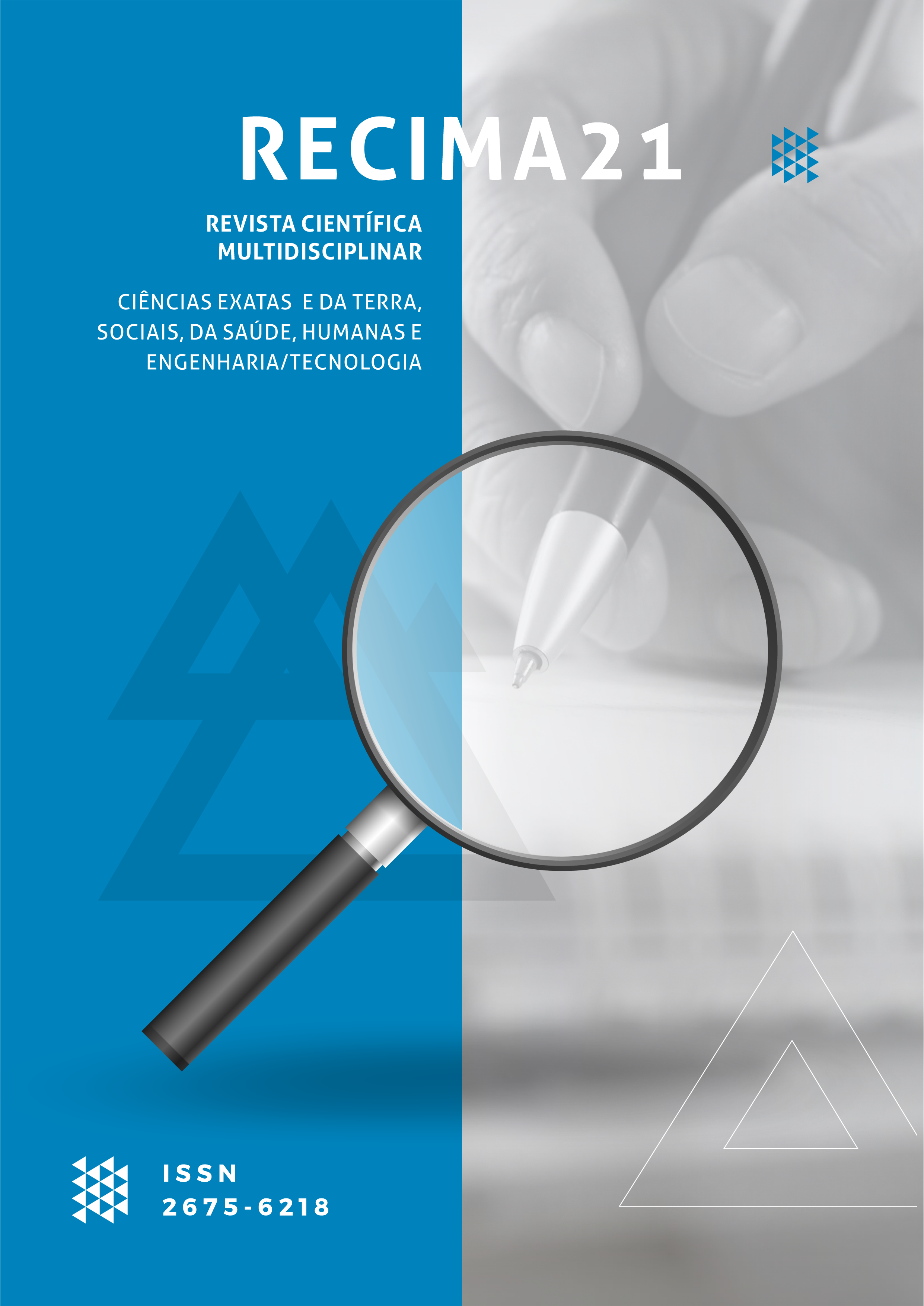BODY DISSATISFACTION AND BODY IMAGE DISORDERS REFERRED TO FROM MEDIA AND SOCIAL NETWORKS
DOI:
https://doi.org/10.47820/recima21.v3i6.1623Keywords:
Body Dysmorphic Disorder, Social Media, Body dissatisfactionAbstract
The term “dysmorphophobia”, used for the first time in 1886 by Enrico Morselli, was integrated into the International Classification of Diseases (ICD) and became known as: Body Dysmorphic Disorder (BDD). This disorder, which affects mostly young people, has by definition excessive concern with body aesthetics. Therefore, this study aims to discuss BDD and the influences of social media on body image and its disorders. An explanatory narrative review study was chosen from a qualitative approach, and articles in English and Spanish were used, between the years 2017 and 2021, present in the Pubmed and Bireme databases. From the results found, an analysis and discussion was carried out through four topics, they are: Body dysmorphism associated with other disorders, family influence, influence of the media and social networks and factors related to sex. With this, it was possible to observe the existence of obstacles for a correct diagnosis of BDD and the importance of performing a complete and effective anamnesis.
Downloads
References
ALMEIDA MSC, et al. Classificação Internacional das Doenças - 11a revisão: da concepção à implementação. Revista de Saúde Pública, v. 54, p. 104, 2020.
ATTIE, I.; BROOKS-GUNN, J. Development of eating problems in adolescent girls: A longitudinal study. Dev. Psychol. 1989, 25, 70–79.
BAUMAN, Zygmunt. Vida para consumo: a transformação das pessoas em mercadoria. Editora Schwarcz-Companhia das Letras, 2008.
BOEPPLE, Leah et al. Strong is the new skinny: A content analysis of fitspiration websites. Body image, v. 17, p. 132-135, 2016.
BROOKS, Kevin R. et al. Looking at the figures: visual adaptation as a mechanism for body-size and-shape misperception. Perspectives on Psychological Science, v. 15, n. 1, p. 133-149, 2020.
CHEN, Jonlin et al. Association between the use of social media and photograph editing applications, self-esteem, and cosmetic surgery acceptance. JAMA facial plastic surgery, v. 21, n. 5, p. 361-367, 2019.
CORORVE, M B, GLEAVES DH. Body dysmorphic disorder: a review of conceptualizations, assessment, and treatment strategies. Clinical Psychology Review, v. 21, n. 6, p. 949-970, 2001.
DE CARVALHO, Pedro Henrique Berbert; DOS SANTOS ALVARENGA, Marle; FERREIRA, Maria Elisa Caputo. An etiological model of disordered eating behaviors among Brazilian women. Appetite, v. 116, p. 164-172, 2017.
DE VRIES, Dian A. et al. Social media and body dissatisfaction: investigating the attenuating role of positive parent–adolescent relationships. Journal of youth and adolescence, v. 48, n. 3, p. 527-536, 2019.
GOMES, Olga Santana et al. Cirurgia plástica no Brasil: uma análise epidemiológica. Revista Eletrônica Acervo Científico, v. 24, p. e7375-e7375, 2021.
JIOTSA B, et al. Social Media Use and Body Image Disorders: Association between Frequency of Comparing One’s Own Physical Appearance to That of People Being Followed on Social Media and Body Dissatisfaction and Drive for Thinness. International Journal of Environmental Research and Public Health, v. 18, n. 6, p. 2880, 2021.
KILLEN, J.D.; TAYLOR, C.B.; HAYWARD, C.; HAYDEL, K.F.; WILSON, D.M.; HAMMER, L.; KRAEMER, H.; BLAIR-GREINER, A.; STRACHOWSKI, D. Weight concerns influence the development of eating disorders: A 4-year prospective study. J. Consult. Clin. Psychol. 1996, 64, 936–940
MORENO, A. et al. Dismorfofobia: un motivo de consulta oculto en dermatología. Revista argentina de dermatología, v. 98, n. 4, p. 1-10, 2017.
OSHANA A, et al. Minority stress and body dysmorphic disorder symptoms among sexual minority adolescents and adult men. Body image, v. 34, p. 167-174, 2020.
PHILLIPS, Katharine A.; MENARD, William; FAY, Christina. Gender similarities and differences in 200 individuals with body dysmorphic disorder. Comprehensive psychiatry, v. 47, n. 2, p. 77-87, 2006.
RAMOS, Kátia Perez. Escala de Avaliação do Transtorno Dismórfico Corporal: propriedades psicométricas. 2009. 129 f. Tese (Doutorado em Psicologia) - Pontifícia Universidade Católica de Campinas, Campinas, 2009.
SHROFF, Hemal; THOMPSON, J. Kevin. The tripartite influence model of body image and eating disturbance: A replication with adolescent girls. Body image, v. 3, n. 1, p. 17-23, 2006.
SLATER, Michael D. Reinforcing spirals: The mutual influence of media selectivity and media effects and their impact on individual behavior and social identity. Communication theory, v. 17, n. 3, p. 281-303, 2007.
STORMER, S.M.; THOMPSON, J.K. Explanations of body image disturbance: A test of maturational status, negative verbal commentary, social comparison, and sociocultural hypotheses. Int. J. Eat. Disord. 1996, 19, 193–202.
THOMPSON, J. Kevin et al. Exacting beauty: Theory, assessment, and treatment of body image disturbance. American Psychological Association, 1999.
VALKENBURG, Patti M.; PETER, Jochen. The differential susceptibility to media effects model. Journal of communication, v. 63, n. 2, p. 221-243, 2013.
WANG, Jordan V. et al. Patient perception of beauty on social media: Professional and bioethical obligations in esthetics. Journal of cosmetic dermatology, v. 19, n. 5, p. 1129-1130, 2020.
Downloads
Published
How to Cite
Issue
Section
Categories
License
Copyright (c) 2022 RECIMA21 - Revista Científica Multidisciplinar - ISSN 2675-6218

This work is licensed under a Creative Commons Attribution 4.0 International License.
Os direitos autorais dos artigos/resenhas/TCCs publicados pertecem à revista RECIMA21, e seguem o padrão Creative Commons (CC BY 4.0), permitindo a cópia ou reprodução, desde que cite a fonte e respeite os direitos dos autores e contenham menção aos mesmos nos créditos. Toda e qualquer obra publicada na revista, seu conteúdo é de responsabilidade dos autores, cabendo a RECIMA21 apenas ser o veículo de divulgação, seguindo os padrões nacionais e internacionais de publicação.













